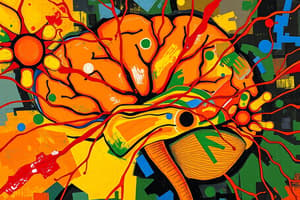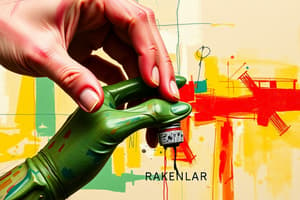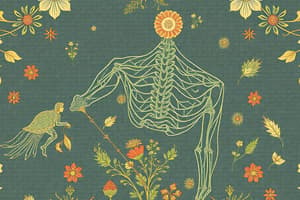Podcast
Questions and Answers
What are the four sensorimotor control problems that the nervous system deals with to control movement?
What are the four sensorimotor control problems that the nervous system deals with to control movement?
The four sensorimotor control problems that the nervous system deals with to control movement are: 1. How sensory information is used to plan and control movement. 2. How the central nervous system coordinates muscles and joints to generate functional movement. 3. How sensory, cognitive, and motor systems, tasks, and the environment affect motor behavior. 4. How individuals adapt to different constraints imposed on movement and learn motor behavior.
What are the fundamental features governing the control of standing, walking, reaching, and eye movements?
What are the fundamental features governing the control of standing, walking, reaching, and eye movements?
The fundamental features governing the control of standing, walking, reaching, and eye movements include sensory information processing, coordination of muscles and joints, and the influence of factors such as cognition and the environment.
How does sensorimotor control utilize sensory information from the environment and body?
How does sensorimotor control utilize sensory information from the environment and body?
Sensorimotor control utilizes sensory information from the environment and body to plan and control movement.
What factors affect movement?
What factors affect movement?
How does injury affect movement and motor behavior?
How does injury affect movement and motor behavior?
Study Notes
Sensorimotor Control Problems
- The nervous system must address variability in motor outputs caused by external forces and individual differences.
- It deals with environmental unpredictability, requiring adjustments to movements based on changing surroundings.
- Sensorimotor control must integrate multiple sensory inputs for accurate movement execution.
- The system needs to manage redundancy in musculoskeletal components to ensure effective, flexible movement strategies.
Fundamental Features of Movement
- Standing control relies on the balance and coordinated muscle activity to maintain posture against gravity.
- Walking involves rhythmic and coordinated limb movements, integrating sensory feedback for stability and direction.
- Reaching requires spatial awareness, motor planning, and precise control of limb trajectory toward a target.
- Eye movements are governed by visual feedback and the need to stabilize images on the retina while tracking objects.
Utilization of Sensory Information
- Sensory information from the environment informs the nervous system about obstacles, textures, and surfaces.
- Proprioceptive feedback from muscles and joints aids in assessing body position and movement status.
- Visual and vestibular inputs are crucial for maintaining balance and coordinating eye and body movements.
- Sensorimotor control combines multiple sensory modalities to produce adaptive responses to the environment.
Factors Affecting Movement
- Individual differences in strength, flexibility, and coordination impact overall motor performance.
- Environmental context such as terrain, lighting, and obstacles influences movement strategies.
- Psychological factors, including motivation and fatigue, can affect focus and execution of movements.
- Age-related changes and neurological conditions may impair sensorimotor function, altering movement dynamics.
Impact of Injury on Movement
- Injuries can disrupt the normal mechanics of movement, leading to compensatory strategies that may cause further issues.
- Loss of sensory input from damaged nerves affects proprioception and balance, hindering movement control.
- Motor impairments post-injury may result in altered muscle activation patterns and movement execution.
- Rehabilitation focuses on restoring sensorimotor function and adapting movements to accommodate physical limitations.
Studying That Suits You
Use AI to generate personalized quizzes and flashcards to suit your learning preferences.
Description
Test your knowledge on sensorimotor control with this quiz. Learn about the four sensorimotor control problems that the nervous system deals with in order to control movement, as well as the fundamental features governing standing, walking, reaching, and grasping.




